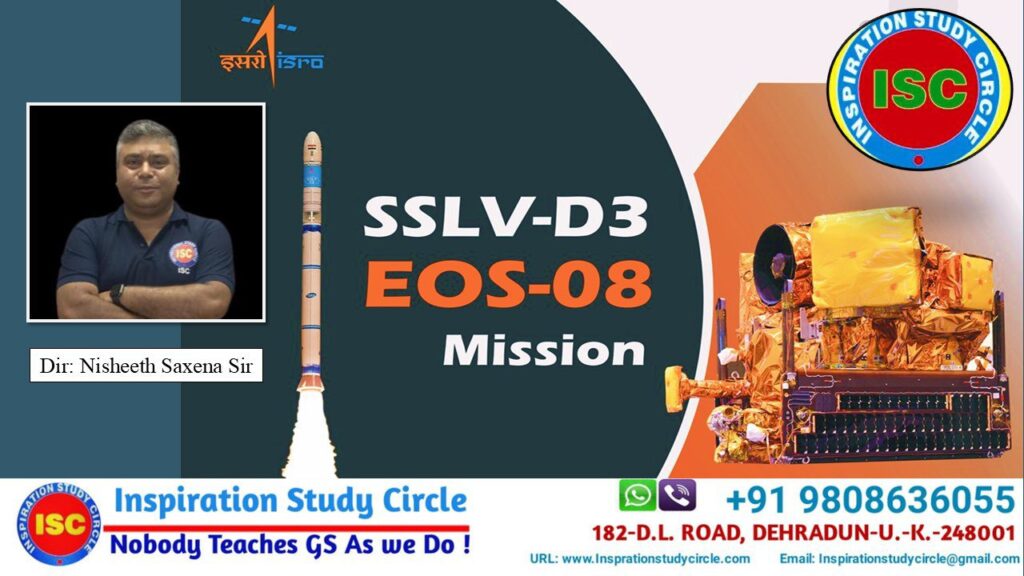
UPSC 2026 Notification Postponed
UPSC 2026 Notification Postponed Table of Contents UPSC 2026 Notification Postponed UPSC Exam 2026 is an All-India Civil Services Exam
The Indian Space Research Organisation (ISRO) has successfully launched the EOS-08 Earth Observation Satellite using the Small Satellite Launch Vehicle (SSLV)-D3. This marks the third and final test flight of the SSLV, officially completing its development phase. The launch occurred from the Satish Dhawan Space Centre in Sriharikota on 16th August 2024 at 9:17 am. Seventeen minutes after liftoff, the satellite was placed into a precise orbit 475 km above the Earth. “The third developmental flight of SSLV, the SSLV-D3 with the EOS-08 satellite, has been accomplished. The rocket has placed the spacecraft in a very precise orbit as planned. I find that there are no deviations in the injection conditions. The current indication is that everything is perfect,” ISRO Chairman S Somanath said after the successful launch.

EOS-08 is a first-of-its-kind mission built on a standard ISRO’s Microsat/IMS-1 bus with advanced payloads for observation in the IR range, a novel GNSS-R Payload, and a SiC UV dosimeter.
The satellite carries a host of new technology developments in satellite mainframe systems like an Integrated Avionics system – Communication, Baseband, Storage and Positioning (CBSP) Package, Structural panel embedded with PCB, embedded battery, Micro-DGA (Dual Gimbal Antenna), M-PAA (Phased array antenna) and Flexible solar panel & Nano star sensor etc for onboard Technology Demonstration. The satellite is slated for launch by the SSLV-D3.
The satellite carries three payloads: Electro Optical Infrared Payload (EOIR), SAC, Global Navigation Satellite System- Reflectometry payload (GNSS-R), SAC and SiC UV Dosimeter, and LEOS.
Mr. Somanath said that with the success of the SSLV-D3, ISRO has declared the development process of SSLV completed. “We are in the process of transfer of the technology of the SSLV to the industry and for serial production and launch of SSLV, this is a great beginning,” Mr. Somanath said.
The spacecraft mission configuration is set to operate in a Circular Low Earth Orbit (LEO) at an altitude of 475 km with an inclination of 37.4° and has a mission life of 1 year. Also onboard was the SR-0 DEMOSAT developed by Space Kidz India which was also placed in the intended orbit.
The SSLV is capable of launching Mini, Micro, or Nanosatellites (10 to 500kg mass) into a 500 km planar orbit. SSLV is a three-stage launch vehicle with all solid propulsion stages and a liquid propulsion-based Velocity Trimming Module (VTM) as a terminal stage.
According to ISRO, the design drivers of SSLV are low cost, low turn-around time, flexibility in accommodating multiple satellites, launch-on-demand feasibility, minimal launch infrastructure requirements, etc.
In a nutshell, the mission comprises the following major points:
The Small Satellite Launch Vehicle (SSLV) is capable of launching Mini, Micro, or Nanosatellites (10 to 500kg mass) into a 500 km planar orbit. SSLV is a three-stage launch vehicle with all solid propulsion stages and a liquid propulsion-based Velocity Trimming Module (VTM) as a terminal stage.
Design drivers of SSLV are Low cost, low turn-around time, flexibility in accommodating multiple satellites, launch-on-demand feasibility, minimal launch infrastructure requirements, etc.
SSLV-D3 is the third developmental flight of SSLV.
The objectives of the SSLV- D3 were:
SSLV-D3 Vehicle characteristics:
Vehicle Height: 34 m
Vehicle Diameter: 2 m
Lift off Mass: ~119 t
Vehicle Configuration: SS1 + SS2 + SS3 + VTM
SSLV-D3 Mission Specifications:
Altitude (km): 475 km
Inclination (deg): 37.4
Launch Pad: FLP
Launch Azimuth (deg): 135
India’s space exploration future looks promising, as the country has been making significant progress in the field in recent years. The Indian Space Research Organisation (ISRO) has been actively involved in various space missions and has set ambitious goals for the future.
Overall, India’s space exploration future is characterized by its determination to expand its capabilities, explore new frontiers, and contribute to scientific knowledge. With ambitious missions, technological advancements, and a growing space industry, India is poised to make significant contributions to the global space community in the coming years.
Disclaimer: the above-mentioned article is based on information from the Press Information Bureau of India Brochure, and the Hindu.
Recent post:-

UPSC 2026 Notification Postponed Table of Contents UPSC 2026 Notification Postponed UPSC Exam 2026 is an All-India Civil Services Exam

Inspiration Study Circle- Best UPSC 2027 Coaching Table of Contents Inspiration Study Circle- Best UPSC 2027 Coaching UPSC Exam 2027

Buddha Relics Return to India after 127 Years “How India Pulled off a Swift Repatriation?” Table of Contents In January 2026, India

Explained: What is happening in Venezuela? Table of Contents Explained: What is happening in Venezuela? In January 2026, Venezuela is experiencing

ISC Explained: Manual Scavenging in India Table of Contents ISC Explained: Manual Scavenging in India Manual scavenging in India is a

The SHANTI Act 2025 Table of Contents The SHANTI Act 2025 The Sustainable Harnessing and Advancement of Nuclear Energy for Transforming